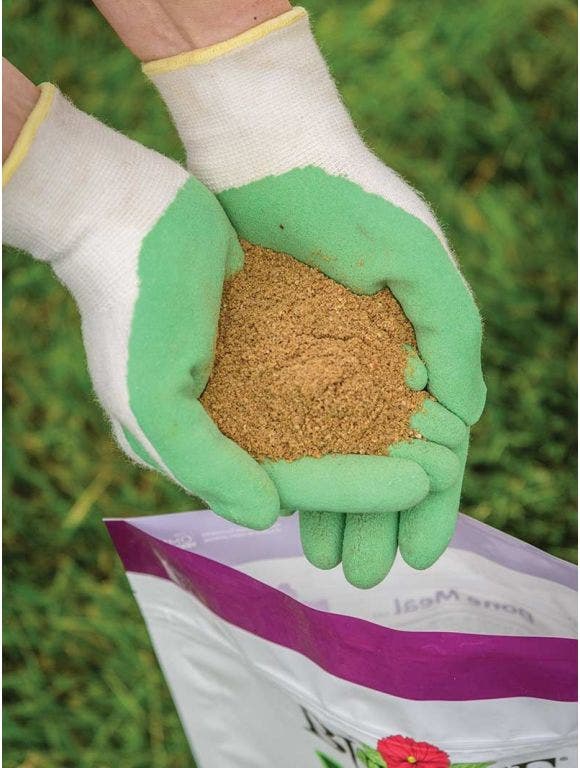


It's been said that a good garden starts with good soil. That's because plants rely on soil for their sustenance. Just like humans need proteins, fats and carbohydrates, plants need nitrogen, phosphorous and potassium — collectively known as N-P-K.
Flower fertilizer supplies nitrogen to promote foliage growth, phosphorous (or phosphate) for flowering and fruit formation, and potassium (or potash) for the growth and development of healthy roots and better drought resistance. Packaged fertilizers list the percentage of these three macronutrients on the label. So a bag of fertilizer labeled 4-6-4 contains 4% nitrogen, 6% phosphorous and 4% potassium, with the rest made up of filler ingredients.
Of course, plants draw carbon from the air and hydrogen and oxygen from water. But they also need secondary nutrients (calcium, magnesium and sulfur) and trace amounts of micronutrients (boron, chlorine, copper, iron, manganese, molybdenum and zinc). Without them, they can have stunted growth, reduced productivity and abnormal or discolored foliage.
Sandy, acidic or peat soils are most likely to be lacking essential nutrients, but a soil test is the only way to know for sure. An electronic soil tester will uncover macronutrient needs as well as pH levels, which affect the availability of nutrients to roots. To determine micronutrient deficiencies, you can arrange for a complete soil test through your cooperative extension service.
What Fertilizer to Use
Fertilizer types include granular, powdered, pelletized, liquid and water-soluble crystals. There are many different formulations as well and some are even specific to the plant. For example, a fertilizer with a 4-6-4 ratio of N-P-K is great for heavy-feeding roses. A water-based fertilizer gives a quick-acting boost to plants but leaches out of soil relatively quickly, so it has to be reapplied every few weeks. Meanwhile, a time-release fertilizer saves time and effort since you don't have to continually reapply it. And to give a boost to a large flowerbed, try a fertilizer that attaches directly to a garden hose.
When to Fertilize Flower Beds
Fertilizer should be applied in spring right after growth resumes and again after flower buds form. If the weather is cool, use a water-based fertilizer because time-release fertilizers won't activate until soil temperatures warm. If you're deciding when to fertilize flower beds later in the season, a good time is right before weeding — as you pull up weeds, the fertilizer granules will come into contact with the soil. Apply evenly, scratching the fertilizer into the soil where needed, then water the bed. This will start to dissolve the granules to release fertilizer and remove any fertilizer dust that lands on leaves.
How Often to Fertilize Flower Beds
This depends on the type of fertilizer you're using, so be sure to follow the directions on the label. Slow-release fertilizers are coated to release nutrients gradually over time. They're typically good for three months or more, so they only need to be applied once or twice per growing season. Water-soluble fertilizers, on the other hand, provide a rapid burst of nutrients. Although they'll show results quickly, they need to be reapplied every couple of weeks to maintain effectiveness. Some gardeners put down a slow-release fertilizer at the start of the season and then apply one or two rounds of water-soluble fertilizer to kick-start growth.


Which Flowers to Fertilize
Annuals in particular need regular fertilizing because they're actively growing and blooming throughout the season. But perennials can also benefit from fertilizers that help them develop a better root system to withstand dry spells and cold weather. Ideally, you can pair the fertilizer with the plant, which is especially helpful with acid-loving flowering shrubs like azalea, rhododendron and camellia. And if you have results from a soil test, you can pinpoint exactly what's needed, then apply it. For example, blood meal can be added for nitrogen, while soil low in phosphorous can be supplemented with bone meal.
Flowers That Don't Need Fertilizer
Some plants are light feeders and don't need fertilizing, such as aster, monarda (aka beebalm), asclepias tuberosa (aka butterfly weed), echinacea (aka coneflower) and veronica. In some cases, too much nitrogen may even cause weak stems and misshapen growth. Generally, plants grown in shade need less fertilizing than those in the sun. This is also true of plants that you mulch annually with compost or leaf mold.
How Fertilizing Affects Flower Health
Fertilizer isn't a cure-all for plant problems. Plants still need suitable soil and proper light and moisture levels for good growth. Fertilizers simply provide the essential elements plants need to do their jobs properly. Lacking those elements, plants are more susceptible to insect and disease problems as well as drought stress. They're also less vigorous and less attractive. Foliage is often distorted and discolored, and flowers are smaller and in shorter supply or missing altogether.
Flower fertilizer has the ability to turn flower beds up a notch in the looks department. But the results will be more impressive if you make sure the plants are happy to begin with.
Learn more about creating a happy environment for flowers in Burpee's guide to flower gardening for beginners.



